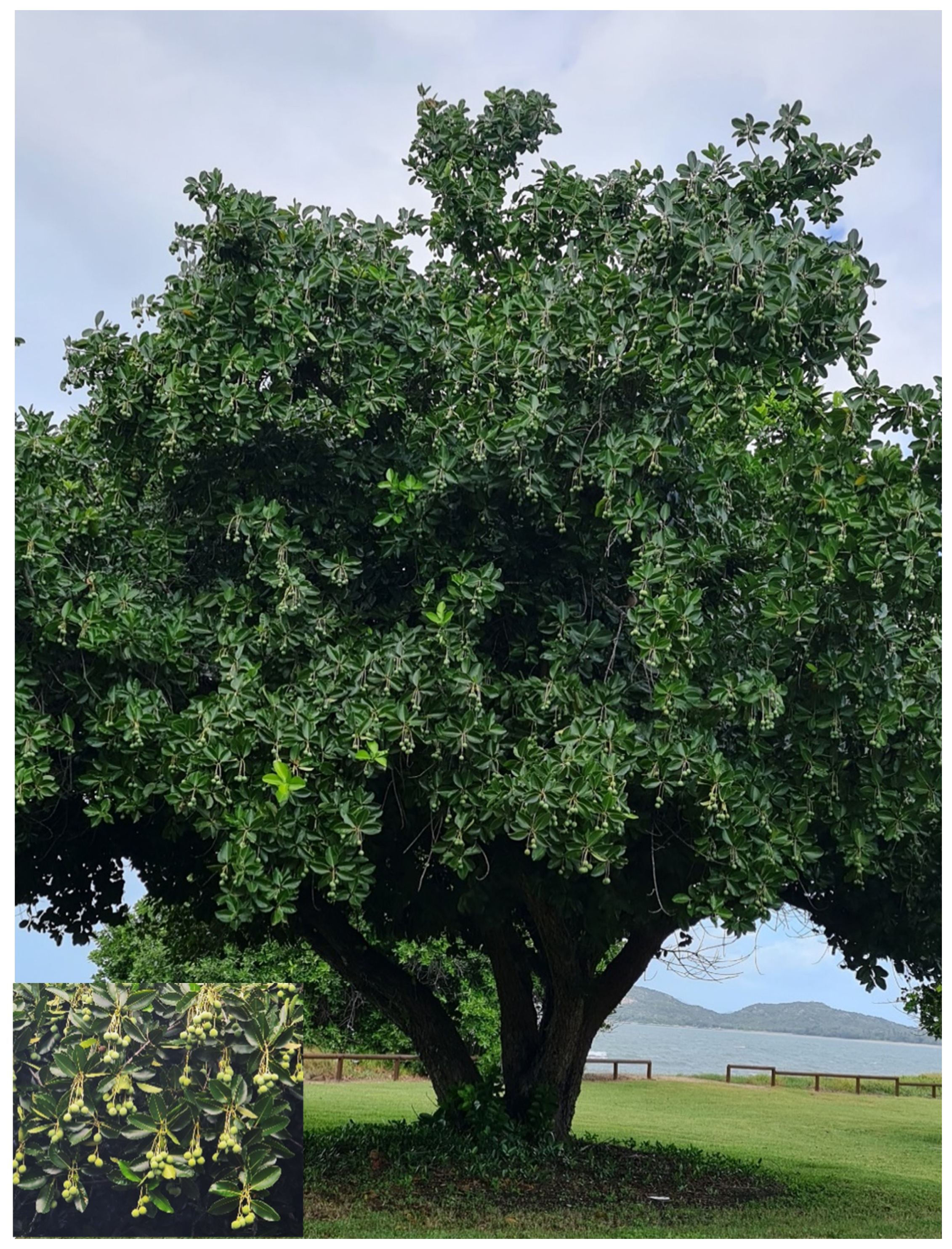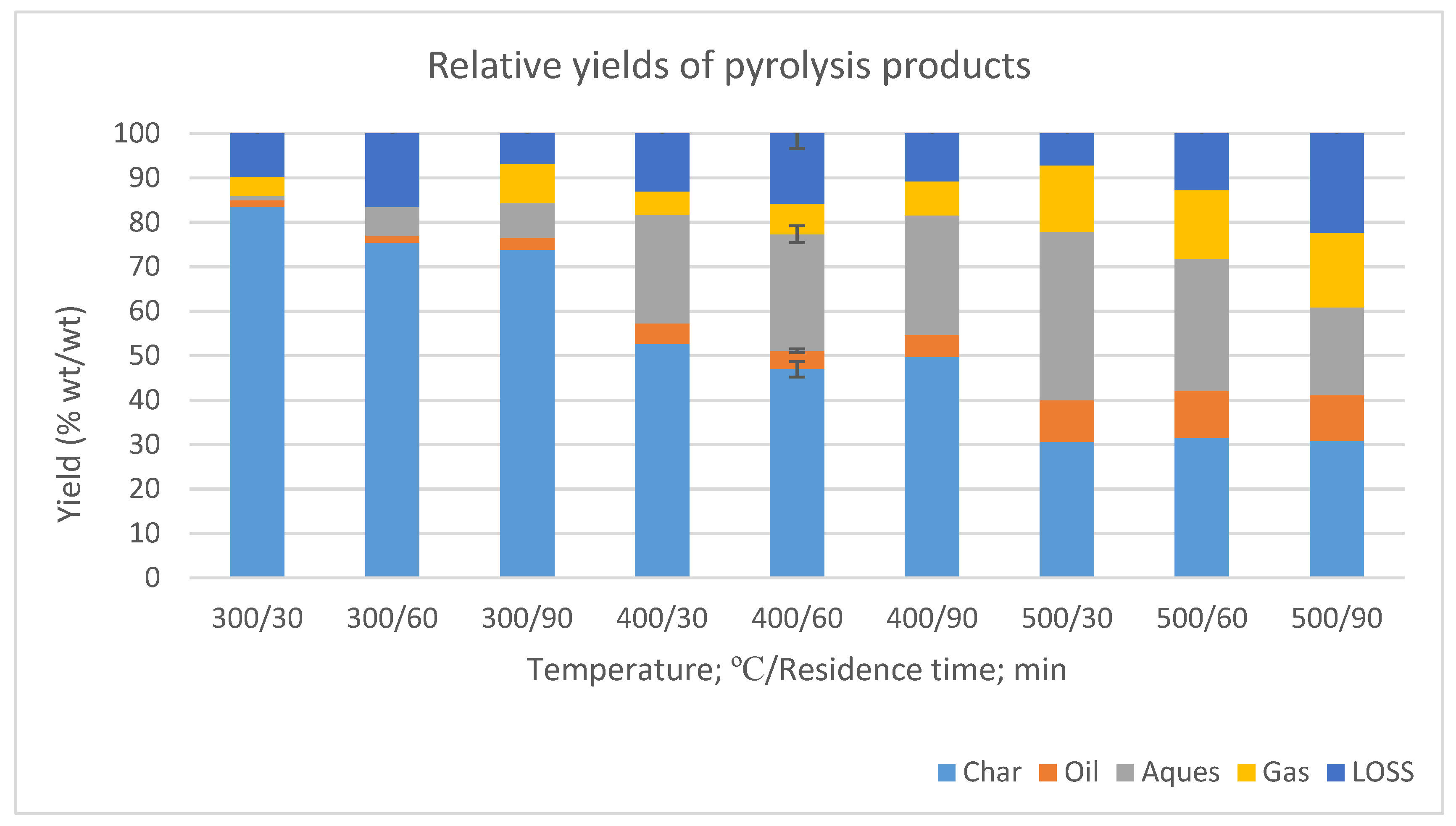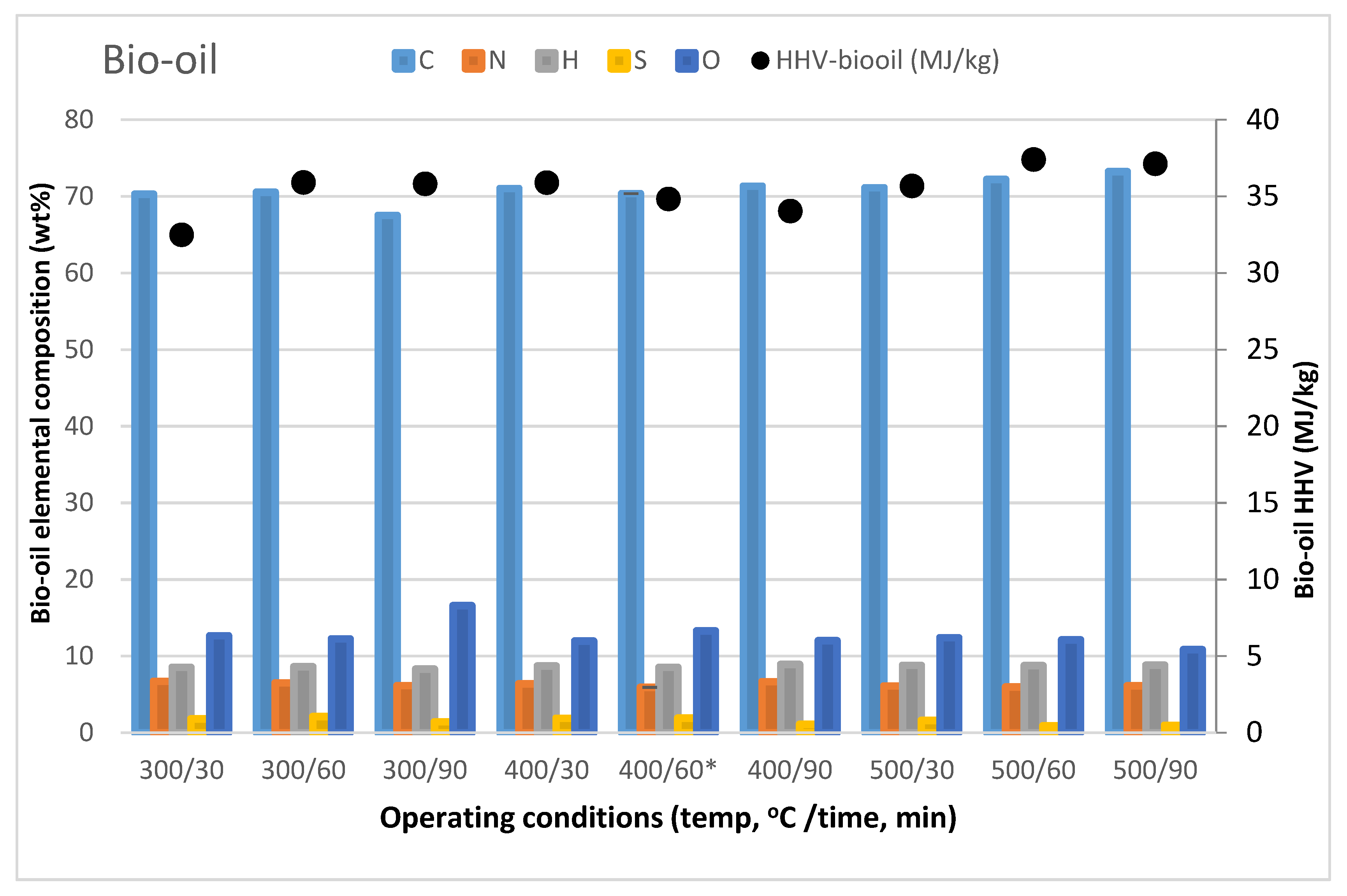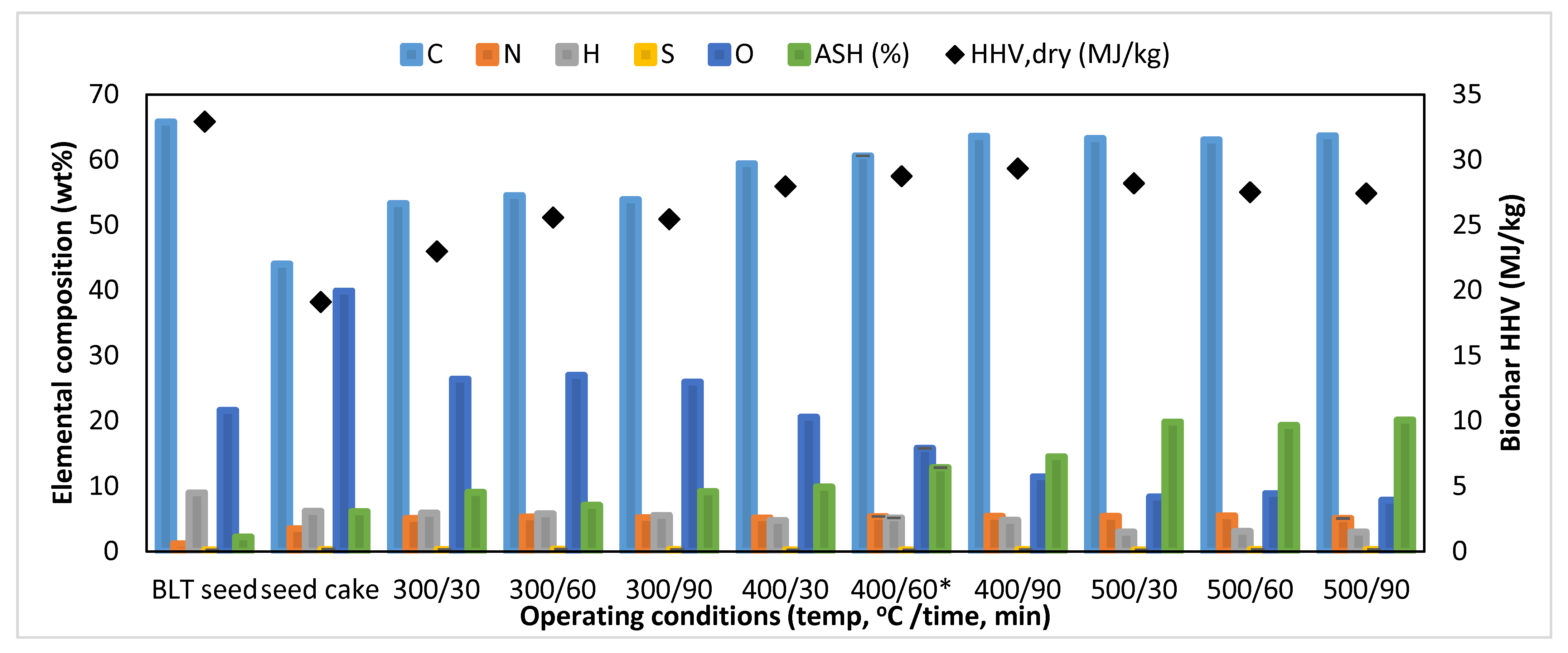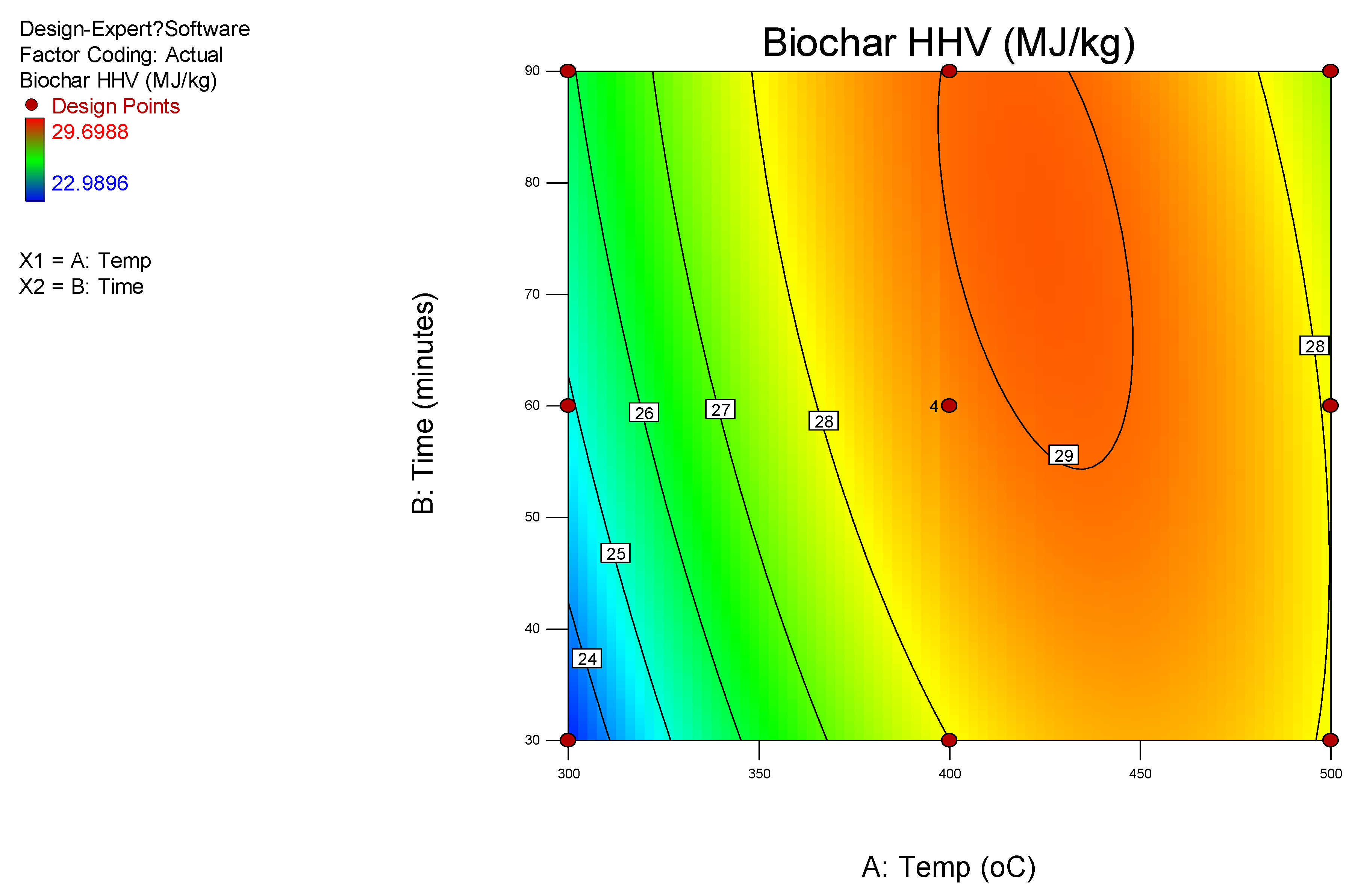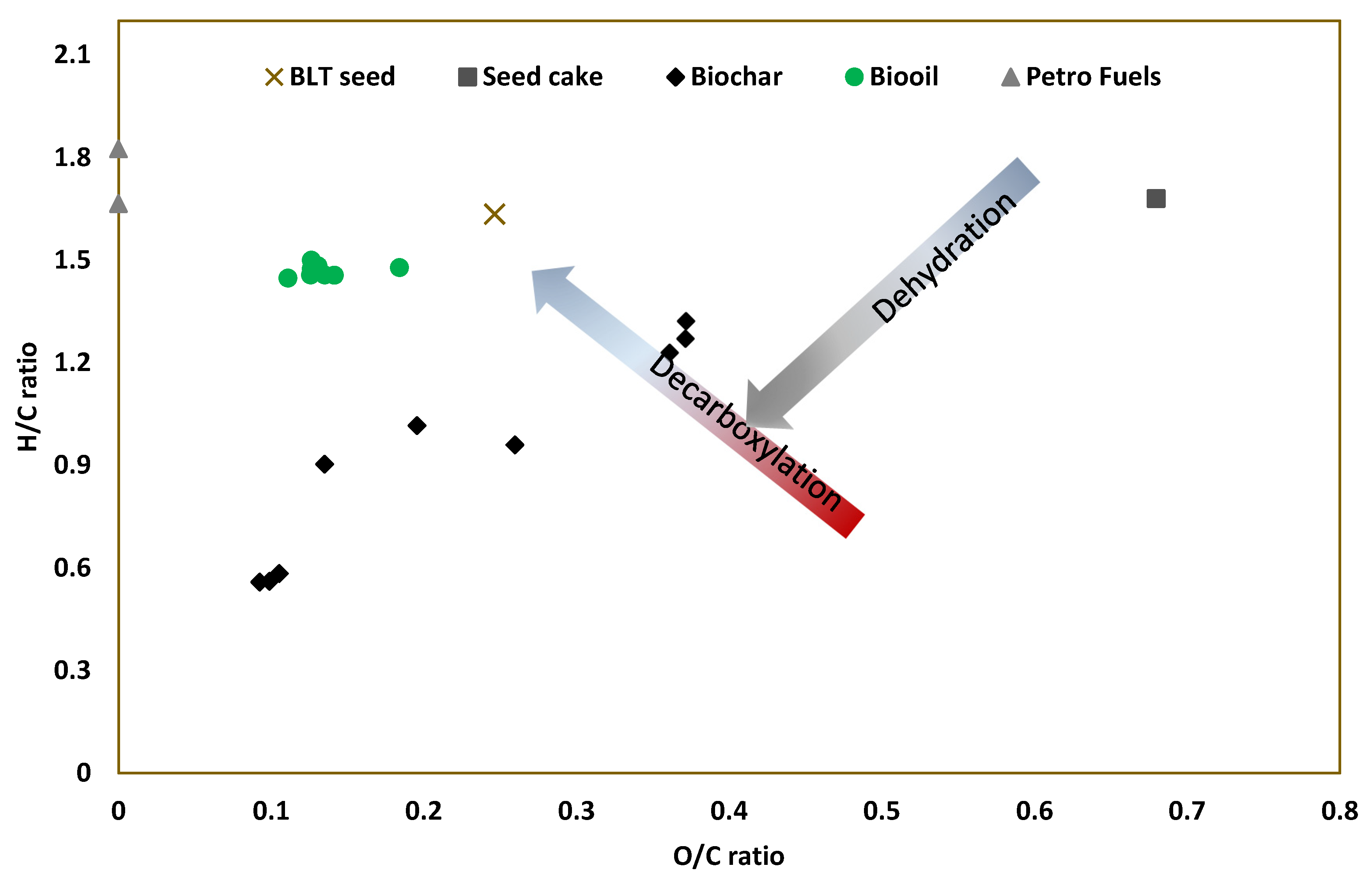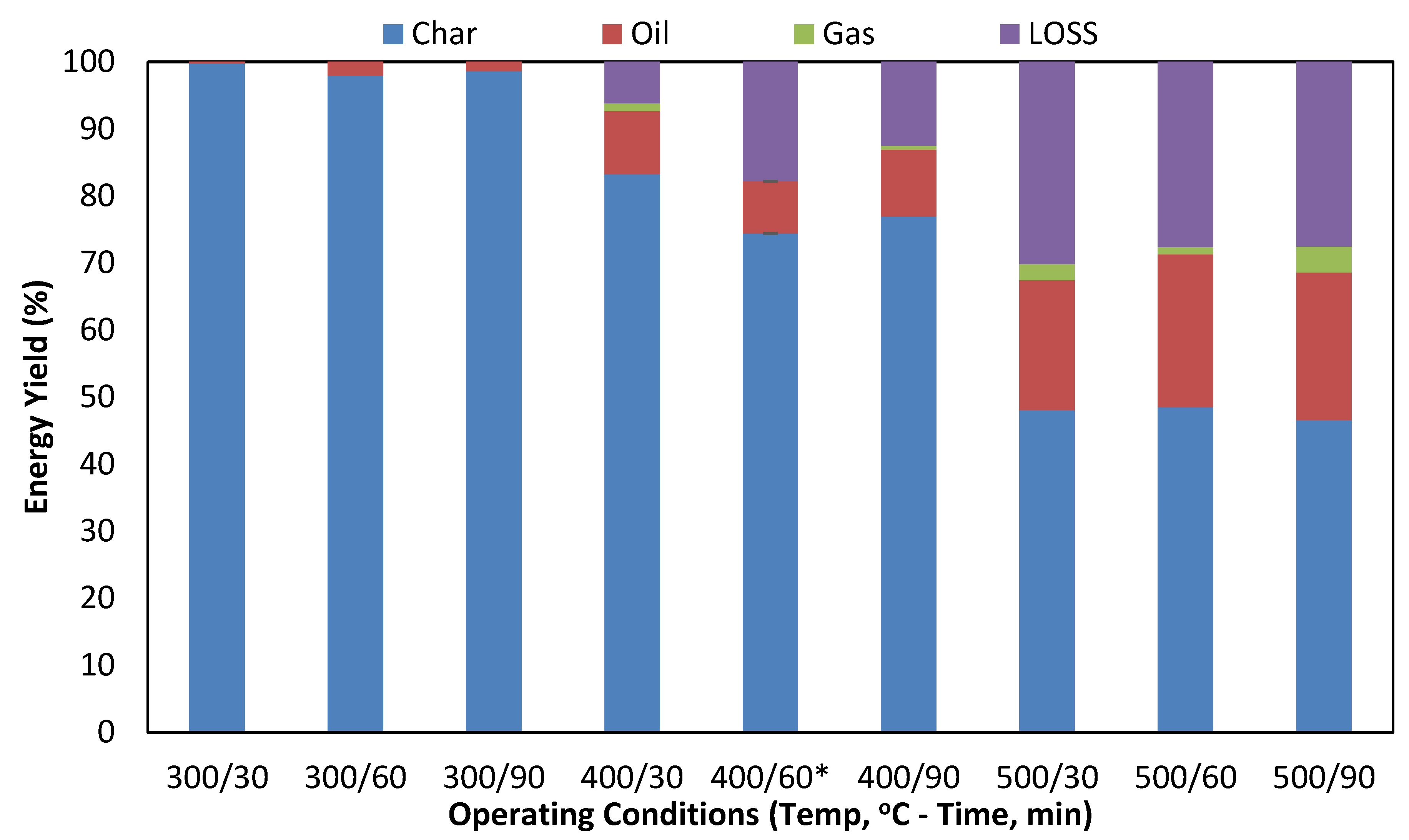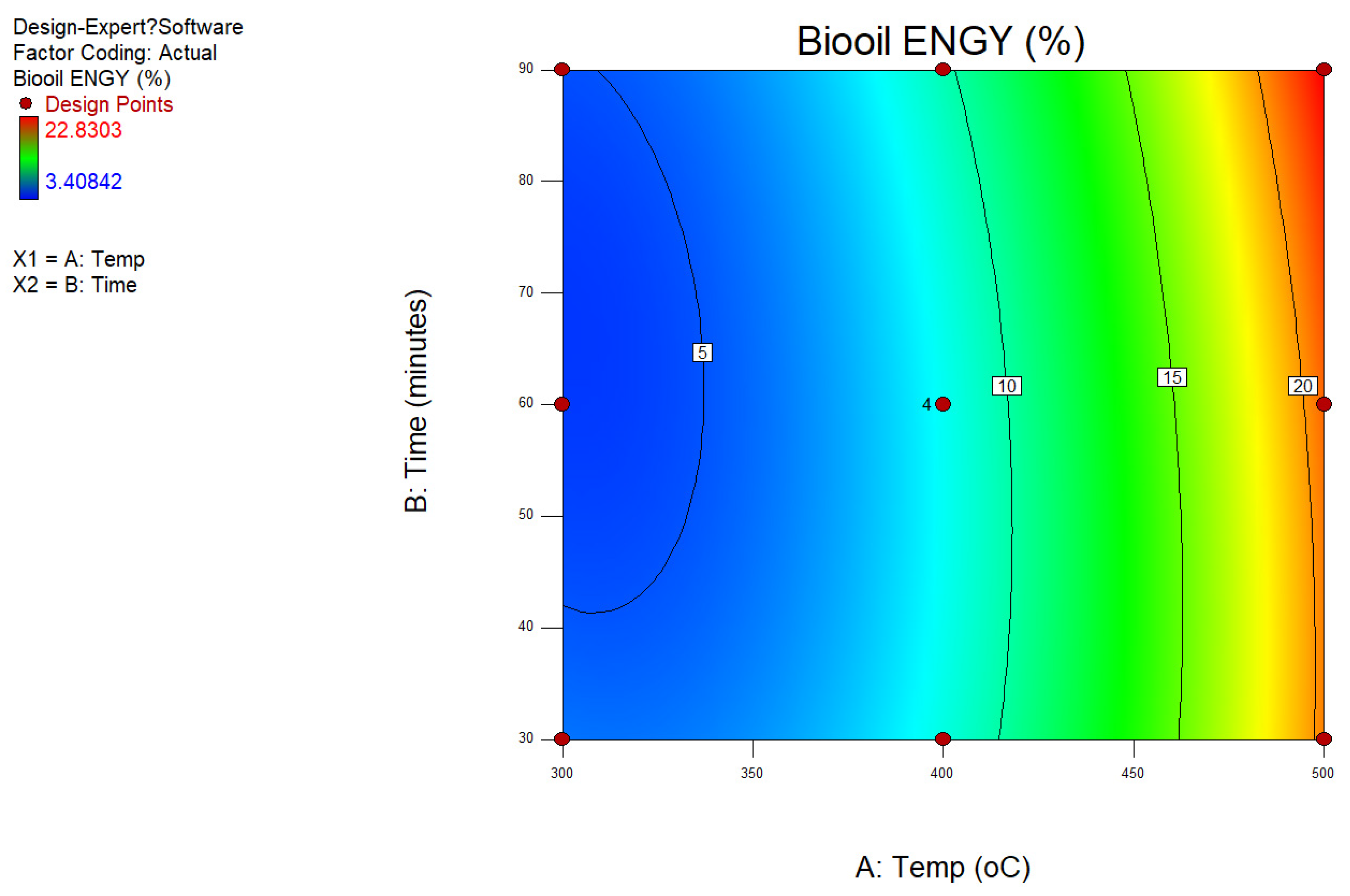1. Introduction
Forest wastes comprised the second largest biomass resource produced in the coastal areas of Queensland and the Northern Territory of Australia [
1]. These wastes include bark and post-harvest residues. Additional wastes are also produced continuously as green wastes. These wastes can be used in biofuel generation. However, there is a need to understand the energy and mass balances in the waste products, including those in the oil seed extraction process to better utilize the energy from the spent wastes to improve the overall economics of biofuels production. Hence, the overall goal of the current study was to evaluate the distribution of mass and energy contained in the spent press cake, as it undergoes controlled thermal treatment during pyrolysis process. By careful selection of the temperature and exposure times, it is possible to optimize conditions needed to maximize energy recovery from the spent waste materials.
Various studies have shown that Beauty Leaf Tree (BLT) is a potential source of non-edible and non-food competing oil for producing biodiesel, due to its ability to grow in a wide range of climatic conditions, easy cultivation, high fruit production rate and high oil content in its seeds [
2,
3,
4,
5]. This plant is native to coastal areas of Queensland, Western Australia and Northern Territory of Australia. Additional studies have also demonstrated optimized biodiesel production via second-generation biodiesel methods [
3,
4], and the fuel properties were found to be resembling those of conventional diesel fuel and another edible oil-derived biodiesel [
6,
7].
There have been many efforts to replace fossil-fuel-based engine fuels with plant or animal derived biofuels over the last decade [
3,
7]. However, one major challenge to commercialize biofuels made from non-food sources has been its overall cost of production [
8] and energy cost [
9]. According to the US Department of Energy, biodiesel made from virgin soybean oil is energy efficient, yielding 3.2 units of fuel energy for every 1 unit of fossil fuel energy used to produce it, while reducing lifecycle CO
2 emissions by 78% [
9]. Other non-edible based biodiesel will not have similar positive net energy balance. Studies are therefore warranted to prove this positive energy balance for each new source of oil for biodiesel production. Likewise, the competitiveness of biodiesel from non-food sources is a strong function of crude oil prices. As the crude oil price drops to below
$100 a barrel, so does the competitiveness of biodiesel production, and this must be considered when developing new biofuels from plants [
10]. Further engine testing and emissions characteristics of BLT biodiesel have shown baseline ASTM standard values in comparison with other non-edible oil seed biodiesel such as jatropha and jojoba [
7].
Large quantities of pressed oil seed cakes are ubiquitously produced from oil extraction processes [
2,
11,
12,
13]. These cakes must be further converted into high value products to improve the competitiveness and sustainability of this biodiesel fuel production process. One potential pathway is controlled thermal conversion via pyrolysis. Limited studies have been conducted on these recovery processes such as the study conducted by Kongkasawan et al. in 2016 [
11] on the jatropha waste meal, where it was found that more than 50% of the initial biomass of the whole seed remained in the press cake.
Numerous biorefineries around the world produce millions of liters of biofuels from oil seeds [
13]. These companies ignore the importance of spent press cake after oil extraction, and consider this as a waste, particularly when it has toxic substances (e.g., jatropha or calophyllum; [
5,
14]). These biorefineries should realize that significant amounts of energy from the seeds are sequestered in the press cake, as this study will demonstrate.
In a comprehensive study by Jahirul et al. [
15], pyrolysis technology was recommended as the best option to recover energy from wastes due to its numerous socioeconomic advantages and the high efficiency of conversion into bio-oil, biochar and syngas, as compared to other thermochemical conversion processes. Hence, the pyrolysis pathway was chosen for this study.
In the present study, spent (oil extracted) press cake from Beauty Leaf Tree (BLT;
Calophyllum inophyllum L.) seeds [
12] was pyrolyzed using a batch type reactor. BLT was selected as it is easy to cultivate and harvest and produces large amounts of oil-rich fruits (
Figure 1).
The primary reason for using the batch type reactor was to minimize losses of co-products. The properties of the pyrolysis products such as the biochar, bio-oil and gaseous products were thoroughly examined. The optimum conditions for the mass and energy yields were studied by establishing statistical models using response surface methodology (RSM). The results of this study will show improved feasibility for biodiesel production, with the recovery of coproducts.
3. Materials and Methods
3.1. Sample Preparation and Characterisation
The pyrolysis experiments were carried out at BETA Laboratory (
https://betalab.tamu.edu/ accessed on 29 April 2021) of Texas A&M University, College Station, Texas. Beauty Leaf Tree (
Calophyllum inophyllum L.) seeds (kernels) were sourced from Queensland, Australia. The BLT oil was extracted from BLT kernels using a mechanical oil seed press (Komet Press, Germany). Then, the press seed cake, which is a byproduct of biodiesel production, was dried, ground and passed through a 5 mm sieve using the Tyler sieve set (W. S. Tyler, Cleveland, OH, USA) [
12].
PARR isoperibol bomb colorimeter (Model 6200, Parr Instrument Company, Moline, IL, USA) was used to measure the high heating value (HHV) of the sample in accordance with the ASTM D 2015. The elemental composition of the press cake was determined using a Vario-MICRO Elemental Analyzer (ASTM D 3176; Standard Practice for Ultimate Analysis of Coal and Coke). For the proximate analysis, ASTM standard D 3173 (Sample Preparation and Moisture Content Determination), D3175 (Standard Test Method for Volatile Matter for Ash in Biomass) and E1755 (Standard Test Method for Ash in Biomass) methods were used [
14].
3.2. Experimental Facilities
Pyrolysis of BLT seed cake was conducted using a batch type Parr reactor (Series 4580 HP/HT, Parr Instrument Company, Moline, IL, USA) [
12]. A cylindrical electric heater heated the 1.5 L AISI 316 S.S. batch with a thermocouple placed inside the reactor. Temperature and exposure time were controlled with a reactor controller (Series 4840, Parr Instrument Company, Moline, IL). A condenser cooled by an ethanol–water–glycol mixture was used to condense the gas.
Approximately 60 g of the dried seed cake was pyrolyzed each time. The reactor chamber was flushed with N2 gas for 15 min to remove oxygen. The reactor was heated at a rate of about 5 °C/min until the set temperatures (300 °C, 400 °C or 500 °C) were reached. The desired temperature was held each for 30, 60 or 90 min. During pyrolysis, the pyrolyzed gas was condensed (−4 °C), and the volume of the uncondensed gas was measured using a gas meter (METRIS 250, Itron Inc., Owenton, KY, USA). The uncondensed gas was sampled at regular intervals using pre-weighed Tedlar gas sampling bags. After pyrolysis, the reactor was cooled for 10–24 h, prior to collecting the biochar and liquids. The condensed liquid was separated into aqueous (io-liquor) and organic portions (bio-oil) and stored in glass bottles. Weights of the biochar and the liquid were taken soon after collection.
3.3. Analytical Methods
The solid, liquid and gas products of BLT press cake pyrolysis were analyzed. First, the high heating value (HHV) and elemental composition of solid and liquid products were determined using the Parr bomb calorimeter and Vario MICRO Ultimate Analyzer (C, H, O, N and S), respectively as explained in
Section 3.1. The proximate analysis and moisture content analysis for solid pyrolyzed char were determined according to ASTM E1755 and D3172. Moisture content of the bio-oil was also obtained by using a KF Titrino 701 (Metrohm, Riverview, FL, USA) in accordance with the ASTM E203 standard. A gas chromatograph was used to determine the composition (H
2, N
2, O
2, CO, CH
4, CO
2, C
2H
2, C
2H
4, C
2H
6, C
3H
6 and C
3H
8) of pyrolysis gas. The gas chromatograph (GC, SRI Multiple Gas Analyzer MG #1, Torrance, CA, USA) was equipped with a thermal conductivity detector (TCD), a Molecular Sieve 5A 80/100 (3’ 1/8” ID SS, Restek, Centre County, PA, USA) and a ShinCarbon ST 80/120 (2 mm ID SRI 8610C, Restek, Centre County, PA, USA). Argon was used as a carrier gas. The initial temperature of the GC was set at 40 °C and it was increased to 280 °C and held for 18.5 min. The temperature was raised at the rate of 10–20 °C/min. The weights and the energy contents of the BLT press cake and those of pyrolysis products were used to calculate recovery of the masses and energies of pyrolysis products, respectively.
3.4. Experimental Design and Statistical Analysis of Data
The central composite design (CCD) is a type of response surface methodology (RSM), which is often used to optimize pyrolysis conditions, coefficient estimation and to determine the significance of independent factors. The temperature and residence time are the two influential pyrolysis factors used in this study. Central composite face-centered (alpha value = 1) was chosen for temperature (300 °C, 400 °C and 500 °C), and exposure times (30, 60 and 90 min). A combination of temperature and residence time resulted in a set of 12 conditions (
Table 1). It can be noted that the 400 °C and 60 min combination has been replicated 4 times and the others will have one value.
The analysis of variance (ANOVA) was used to explain the fitness of the regression models with a 95% confidence level. This analysis helps to determine if the treatments had any significant effect on biofuel production, and then to identify the treatments that performed significantly better than the other treatments. The higher the value of the coefficient, the greater will be the effect of the factor being tested. With the coefficient values, the F statistic value can be used to determine if the effect of each factor was significant. If the F value (ratio of the mean square of treatments to the error mean square) is large, then the variance by the model is significantly larger than random errors (error variance). Amongst all the response parameters studied, only the solid heating value (MJ/kg), solid energy yield (%) and mass conversion response parameters (wt %) are reported in this paper. All the models were chosen by reducing the terms using both backward and stepwise model selection to avoid collinearity problems, which can result in large standard errors, poor numerical accuracy and wrong partial regression coefficients.
The following equations were used in the data analysis. Mass and energy were balanced with consequent losses. Energy yield shows the magnitude of the energy conversion of the initial biomass after pyrolysis, while the mass product yield represents the mass conversion during the pyrolysis process. The energy density of the pyrolyzed solid products represents the ratio between the increased energy yield and the converted mass yield.
where
5. Conclusions
This paper described optimization of pyrolysis conditions for BLT oil seed press cake, which is a byproduct of oil extraction during biodiesel production process. A previous study [
11] (e.g., jatropha oil seed press cake) shows that a large portion of the energy is still retained in the press cake after oil extraction. The current study further validates this claim and shows that about 61.7% (dry basis) of the energy of the whole seed is still contained in the waste press cake. Hence, to improve the energy balance of biodiesel production, residual energy retained in the press cake must be recovered and thermal processes such as pyrolysis could be relied upon for this purpose.
The results of this research will have a significant impact on projects utilizing Australian natural forest reserves, particularly native trees like BLT. The oil seed from this tree serves as a highly potential source for biodiesel production [
17]. Newer studies are now being implemented in Indonesia to explore the potential of BLT for biodiesel production at the village level [
10,
24]. However, with the price of crude oil still depressed in recent years, the recovery of additional energy from the coproducts must be considered during biodiesel production. Results from this study shows that more than 90% of the energy from the press cake can be recovered via biochar at an optimal condition of 300 °C and exposure time of 30 min. Additional energy may be recovered from the bio-oil sample (organic portion), although this will provide very minimal energy contribution. Hence, a significant amount of energy from the press cake could be optimally recovered by controlled pyrolysis process. Overall, the production of biodiesel must always be undertaken in conjunction with the recovery of additional energy from the press cake. This will likely improve the overall energy recovery and the economics of biodiesel production.
This study has shown how the solid (biochar), liquid (bio-oil) and combustible gas (synthesis gas) coproducts from press cake may be optimized depending upon on the target product based on the relative commercial value of each of the coproducts. In all experimental runs, the biochar energy yield was found to be the highest. Thus, programs to direct production of biochar from press cakes must be developed and enhanced.
